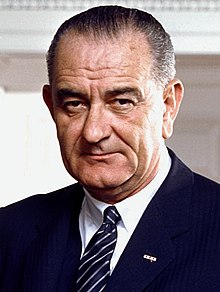President Lyndon B. Johnson
| Lyndon B. Johnson | |
|---|---|

Lyndon B. Johnson in March 1964
|
|
| 36th President of the United States | |
|
In office November 22, 1963 – January 20, 1969 |
|
| Vice President |
|
| Preceded by | John F. Kennedy |
| Succeeded by | Richard Nixon |
| 37th Vice President of the United States | |
|
In office January 20, 1961 – November 22, 1963 |
|
| President | John F. Kennedy |
| Preceded by | Richard Nixon |
| Succeeded by | Hubert Humphrey |
|
United States Senator from Texas |
|
|
In office January 3, 1949 – January 3, 1961 |
|
| Preceded by | W. Lee O'Daniel |
| Succeeded by | William A. Blakley |
| Senate Majority Leader | |
|
In office January 3, 1955 – January 3, 1961 |
|
| Whip | |
| Preceded by | William F. Knowland |
| Succeeded by | Mike Mansfield |
| Senate Minority Leader | |
|
In office January 3, 1953 – January 3, 1955 |
|
| Whip | Earle C. Clements |
| Preceded by | Styles Bridges |
| Succeeded by | William F. Knowland |
| Senate Majority Whip | |
|
In office January 3, 1951 – January 3, 1953 |
|
| Leader | Ernest McFarland |
| Preceded by | Francis J. Myers |
| Succeeded by | Leverett Saltonstall |
| Member of the U.S. House of Representatives from Texas's 10th district |
|
|
In office April 10, 1937 – January 3, 1949 |
|
| Preceded by | James P. Buchanan |
| Succeeded by | Homer Thornberry |
| Personal details | |
| Born |
Lyndon Baines Johnson August 27, 1908 Stonewall, Texas, U.S. |
| Died | January 22, 1973 (aged 64) Stonewall, Texas, U.S. |
| Cause of death | Heart attack |
| Resting place |
Johnson Family Cemetery Stonewall, Texas |
| Political party | Democratic |
| Spouse(s) | Lady Bird Taylor (m. 1934) |
| Children | Lynda Bird and Luci Baines |
| Alma mater | Texas State University |
| Profession | Teacher |
| Civilian awards |
|
| Signature | |
| Military service | |
| Allegiance | |
| Service/branch |
|
| Years of service |
|
| Rank |
|
| Battles/wars | |
| Military awards |
|
Lyndon Baines Johnson (/ˈlɪndən ˈbeɪnz ˈdʒɒnsən/; August 27, 1908 – January 22, 1973), often referred to as LBJ, was an American politician who served as the 36th President of the United States from 1963 to 1969, assuming the office after serving as the 37th Vice President of the United States under President John F. Kennedy from 1961 to 1963. A Democrat from Texas, he also served as a United States Representative and as the Majority Leader in the United States Senate. Johnson is one of only four people who have served in all four federal elected positions.
Born in a farmhouse in Stonewall, Texas, Johnson was a high school teacher and worked as a Congressional aide before winning election to the House of Representatives in 1937. He won election to the Senate in 1948, and was appointed the position of Senate Majority Whip in 1951. He became the Senate Minority Leader in 1953 and the Senate Majority Leader in 1955. As a leader in the Senate, Johnson became known for his domineering personality and the "Johnson treatment", his aggressive coercion of powerful politicians to advance legislation. Johnson ran for the Democratic nomination in the 1960 presidential election. Although unsuccessful, he accepted the invitation of then-Senator John F. Kennedy of Massachusetts to be his running mate. They went on to win a close election over the Republican ticket of Richard Nixon and Henry Cabot Lodge Jr., and Johnson was sworn in as Vice President on January 20, 1961. On November 22, 1963, Kennedy was shot in Dallas, Texas, and died the same day while hospitalized; Johnson succeeded Kennedy as president. The following year, Johnson won a landslide in 1964, defeating Senator Barry Goldwater of Arizona.
...
Wikipedia
